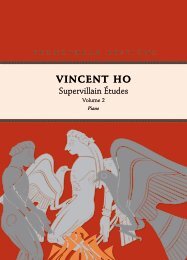Create successful ePaper yourself
Turn your PDF publications into a flip-book with our unique Google optimized e-Paper software.
<strong>Abhisheka</strong> received its premiere performance from the New Zealand String Quartet in Nelson,<br />
New Zealand on 23 August 1998. A recording of the New Zealand String Quartet performing<br />
<strong>Abhisheka</strong> appears on the Rattle Records album Rhythm Spike (RAT D-008), which was<br />
produced by the composer.<br />
Performance notes<br />
• Wherever possible, all four instruments should be close-miked, not to increase the<br />
volume of the ensemble, but to enable the addition of artificial reverb. (c.4 seconds). The<br />
loudspeakers should be as close as possible to the ensemble to facilitate maximum blend.<br />
• All glissandi last for the duration of the note on which they begin, and unless specifically<br />
indicated otherwise, no bow change is intended after a glissando.<br />
• During long-held chords, bow changes should occur asynchronously and imperceptibly.<br />
Likewise, in the solo passages (indicated by dotted slurs), bow changes should be as<br />
discreet as possible. At some points in the score, suggestions for these imperceptible bow<br />
changes are given in brackets.<br />
• In the passage beginning at measure 75, the hairpin dynamics are intended to indicate<br />
an even crescendo and diminuendo, with the peaks of the crescendi gradually increasing in<br />
intensity.<br />
Quarter tone notation<br />
s<br />
W<br />
ß<br />
ƒ<br />
Y<br />
F<br />
– raise note three-quarters of a tone<br />
– raise note half a tone<br />
– raise note quarter of a tone<br />
– lower note quarter of a tone<br />
– lower note half a tone<br />
– lower note three-quarters of a tone<br />
• Whilst standard accidentals are placed in the usual manner, to apply throughout the entire<br />
measure in which they appear, quarter-tone accidentals are placed before every note to<br />
which they apply.<br />
• As a further aid to clarity, in the individual parts the intervals of double-stopped chords<br />
are annotated in shorthand (M2 = major 2nd, m6 = minor 6th, P4 = perfect 4th, etc.).<br />
PE028 – vi


















